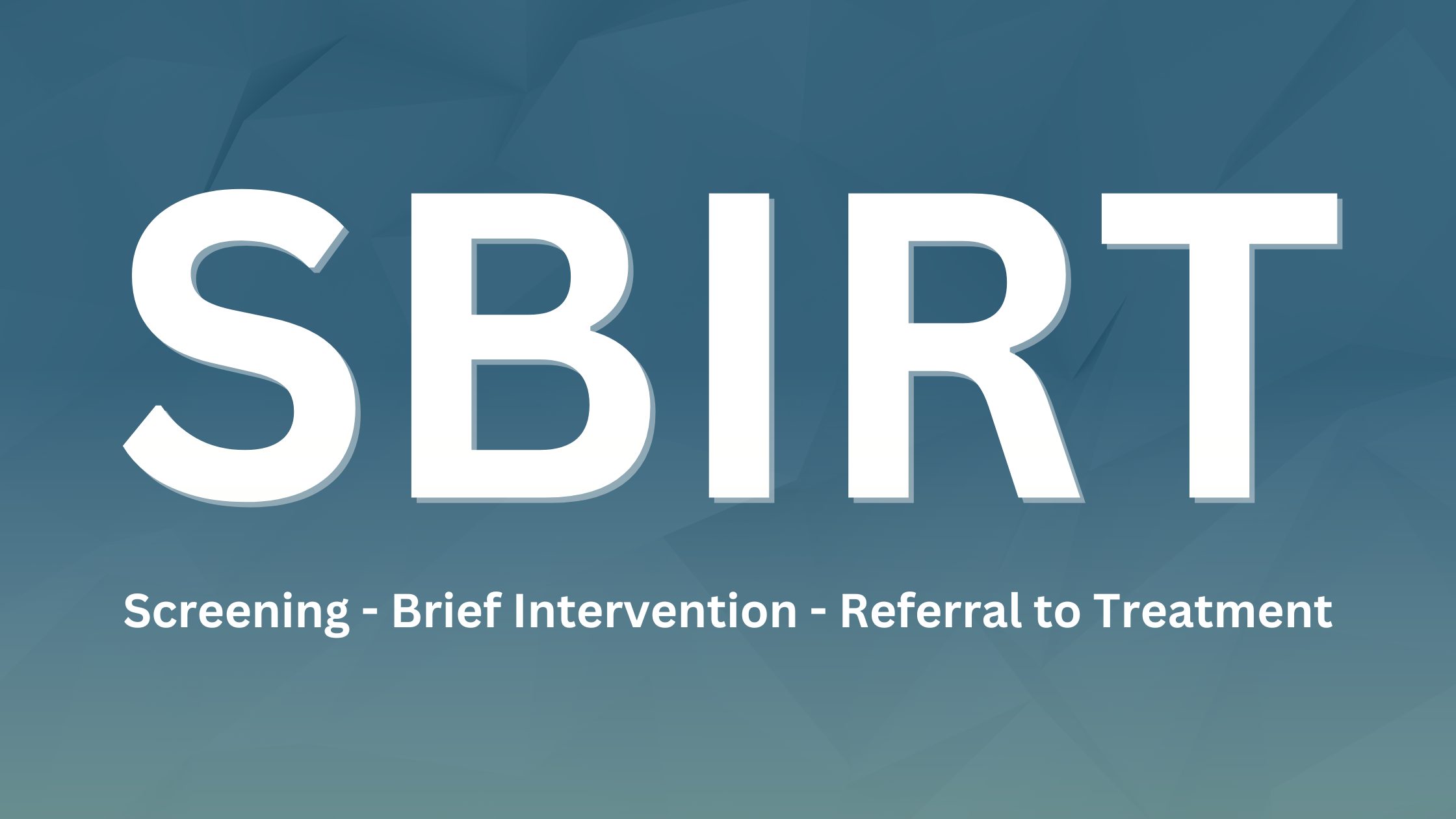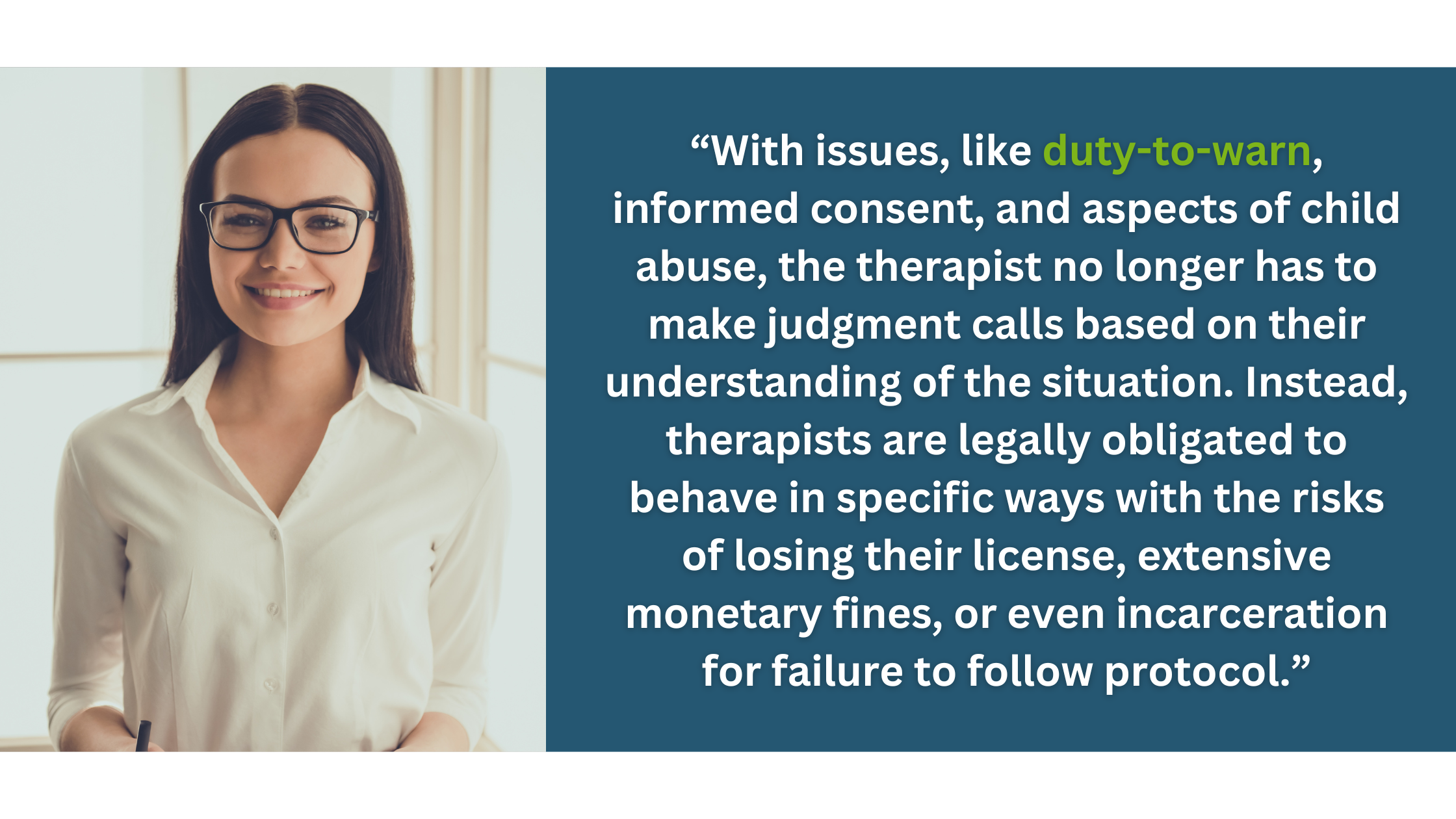
Ethical Considerations in SBIRT: Balancing Confidentiality and Duty to Warn
All mental health professionals must constantly balance good treatment with good ethics. Usually these two work in a harmonious state, but at times, problems arise that put therapists in an uncomfortable or unclear situation, especially during SBIRT assessments. Ethical considerations are best handled with prevention and preparation, rather than with reactivity and uncertainty.
Professionals using SBIRT (Screening, Brief Intervention, and Referral to Treatment) may routinely find themselves encountering ethical dilemmas as they gather information about the individual, their life, and their symptoms. Therapists must also consider the ethical impact of the interventions and referrals they recommend.
Keep reading this mental health and addiction professionals guide to SBIRT to learn more about the SBIRT process and the best ways to navigate some of the most common and compelling ethical issues. Even though therapists may not face tough ethical challenges each day, taking a proactive approach will save a lot of time and stress later.
Instant Download: SBIRT Ethical and Legal Issue Checklist
Download this checklist of ethical and legal concerns to use as an SBIRT guide.

Understanding SBIRT
SBIRT, which stands for Screening, Brief Intervention, Referral to Treatment is a well-regarding assessment process that can quickly and accurately identify a variety of substance use concerns. Though, SBIRT is often associated with substance use disorders, it is useful when assessing for numerous mental health concerns.1
The SBIRT model is comprised of three parts.1
- Screening. The SBIRT screening process aims to identify the presence and severity of numerous conditions, including a range of substance use disorders, and other mental health conditions, like anxiety, depression, and other mood disorders.
- Brief Intervention. As the name indicates, the brief intervention section of the SBIRT model offers the client very short-term measures to improve their situation through increasing insight and awareness of their status. The professional may offer some tools to increase motivation and desire for change.
- Referral to Treatment. The referral to treatment section offers the individual options for treatment that will appropriately address their needs and resolve their symptoms, while promoting safety and comfort. The best referrals are made with or for the client, instead of only encouraging the client to follow through independently.
With luck, the therapist’s EHR integrates SBIRT to make documentation and decision-making clear and effective.

The Benefits of SBIRT
One benefit of SBIRT screening is that once a client shows signs and symptoms of a condition, the therapist can implement a series of full screening tools to better evaluate the presence of mental health conditions. For example, if a client notes symptoms of anxiety and depression, this prompts the therapist to further evaluate the presence of mental health symptoms.
Alternatively, not all people will need all phases of the SBIRT model. If the SBIRT screening shows the person does not have a substance use disorder or other concerning mental health symptoms, there is no need for interventions or referrals. Similarly, some people may only be appropriate for screening and brief interventions with those recommendations offering enough assistance to eliminate the need for follow up care from another provider.2
Another beneficial aspect of the screening is that many professionals in many settings can implement SBIRT clinical tools. A nurse in a primary care physician's office or a therapist working in a community agency or a private practice office can effectively introduce SBIRT skills into their practice.
The Drawbacks of SBIRT
It seems there are some drawbacks to SBIRT as well. Namely, some providers, like those working in primary care, report problems with time and resources. They state there is not enough time to conduct SBIRT in these settings and using SBIRT could take away from other treatment options.
Some other reported drawbacks to SBIRT include:1
- Lack of appropriate referral sources
- High staff turnover
- Limited confidence using the SBIRT screening tools
Despite these concerns, SBIRT is generally a cost-effective and efficient way to begin providing helpful care to people in need. It can also identify issues and concerns that are not necessarily the person’s chief complaint when seeking treatment.
Ethical Principles in Psychology and Behavioral Health
Being an ethical therapist is the cornerstone of being a helpful and effective therapist, but managing ethical predicaments is not always simple or straightforward. Sometimes even clearly identifying the situation as an ethical “gray area” poses a serious challenge.
The ethical principles of therapists, including psychologists, social workers, and professional counselors, is largely based on the age-old principles of physicians. Where physicians focus on autonomy, beneficence, non-maleficence, and justice, therapists’ ethics are based on:3
- Beneficence and Nonmaleficence. Therapists work hard to create some benefit while doing no harm to the individuals they treat.
- Fidelity and Responsibility. Therapists recognize their influence on their clients and the need to act in the best interests of the entire community.
- Integrity. Accuracy, honesty, and truthfulness are essential to the ethical therapist.
- Justice. Therapists should do their best to identify and limit the bias that could impact their treatment of clients in need.
- Respect for People's Rights and Dignity. All people have worth, and the therapist should do their best to maintain privacy, confidentiality, and self-determination.
In a “black or white” world, maintaining the highest standards of ethical behavior is a simple task. Unfortunately, therapists work and live in shades of gray with plenty of ambiguity, uncertainty, and contradictions. Therapists must do what’s best for the individual and what’s best for the community, but what happens when these oppose each other? Therapists must maintain strict confidentiality, but they must protect people from dangerous situations or future harms.
The therapist may not always know the “right” way to handle each situation because there may not be one “right” approach. As long as they approach the challenge from a foundation of these ethical principles, their actions will be justified.
Ethical and Legal Challenges with SBIRT
Over the years, many ethical challenges with therapy have become legal matters. Issues and concerns that presented in the past have been prosecuted in courts of law, so now there are legal expectations that precede the ethical questions. Although some fluidity continues as new cases develop, legal guidelines drive ethical concerns.
It is valuable to note, though, that while ethics are widely open to interpretation, laws are strict and structured. Laws also vary by state, so all therapists should work to ensure they have an accurate understanding of the laws governing their practice.
If a client offers information during a SBIRT process regarding their specific and time-based plan to kill an identifiable person, the therapist knows they must respond in a way that protects the individual at risk. Here, the ethical expectations of privacy and confidentiality are compromised by the need to protect other individuals and the community at large.
The situation is similar in case of child abuse and neglect. Depending on the state, issues of confidentiality are secondary to the goal of protecting children who have been abused.4
With issues, like duty-to-warn, informed consent, and aspects of child abuse, the therapist no longer has to make judgment calls based on their understanding of the situation. Instead, therapists are legally obligated to behave in specific ways with the risks of losing their license, extensive monetary fines, or even incarceration for failure to follow protocol.
Because of these situations, many therapists choose to disclose these concerns at the outset of the screening. By discussing issues of informed consent, confidentiality, and reasons for potential breaches, the client has the tools to make an informed decision.

Ethically-Unclear Case Scenarios Involving SBIRT
The ethically-ambiguous situations are infinite in the world of mental health and SBIRT. There is no way to discuss each one, but by investigating some examples that have thematic relevance, a professional can consider ways to work for the best interests of their clients and their community without compromising their standards.
Example 1: Pregnant Woman Abusing Alcohol and Other Drugs
Numerous challenges present to a clinician conducting SBIRT with a pregnant woman. During the assessment, the mother-to-be reports actively using alcohol, opioids, including heroin and oxycodone, and methamphetamine in the form of crystal meth. Needless to say, any of these substances will have a negative impact on the fetus, and the combination could lead to any number of life-threatening consequences.5
She reports no interest in stopping, despite brief interventions and refuses referrals. So, what does a therapist do with this information? Doing nothing seems like a bad idea, but doing too much could be a violation of legal and ethical standards.
Something to consider would be seeking releases of information with her other providers. By having authorization to speak to her doctors, family members, and the father, the therapist could use them to assess her status and encourage healthier behaviors. Asking the woman to come back for another assessment in a few days or weeks could allow an opportunity for interventions to be more helpful.
Example 2: A Teen With Active Substance Use Disorders
This example involves a 14-year-old who admits to stealing alcohol from parents and drinking daily. What does a therapist do with this information if the client refuses interventions and referrals? Should they tell the parents or keep this information private and confidential, even though it endangers the client?
In most cases, the answer will depend on the state in which the therapist is practicing as issues of consent to treatment vary. In some states, the age of consent to outpatient mental health treatment is 12. It is 16 or higher in other states. If the minor is old enough to consent to treatment, the therapist would need a release of information to avoid breaking confidentiality from a legal perspective.
Many therapists may feel it is ethically appropriate to make a blanket statement to parents, like “I often recommend to parents of teens to take preventative measures by removing prescription medication, alcohol, and weapons from the home to maintain safety.” This could encourage parents to be more diligent without directly breaking confidentiality.
Example 3: An Intoxicated Parent Driving Their Child
What if a therapist completes a SBIRT screening on a parent who admits to frequently driving under the influence of alcohol with their three small children in the car? Does the therapist have a legal or ethical duty to break confidentiality?
Depending on the state and the therapist’s interpretation, the answer could be “yes.” In Pennsylvania, child abuse law states a report to child protective services must be made when someone’s actions are “creating a reasonable likelihood of bodily injury to a child through any recent act or failure to act.” 4 Is there a reasonable likelihood that driving drunk will lead to injury? Many would argue that it would.
The situation is compounded if the parent is actively intoxicated and plans to drive home with their children in the car. Allowing this could endanger the children.
Example 4: A Dual Diagnosis Client Caring for a Older Adult
During the SBIRT process, the therapist learns that a client caring for their elderly parents is actively psychotic and using opioids at high levels daily. The client reports difficulty caring for their own needs and often falls asleep for long periods leaving their parents without food and access to the bathroom.
Just like there are laws in place to ensure the health and well-being of children, older adults are protected by law. Based on this information, it is reasonable to think that these parents are being neglected by their child and not receiving proper levels of care, which ultimately endanger their physical and mental health.
Knowing the rules and regulations surrounding adult protective services in their state is another essential part of being a therapist using the SBIRT model. This situation would likely require breaking confidentiality to make a report.
Example 5: Person Using High Levels of Alcohol and Sedatives
The previous examples focus on information uncovered with the screening process, but plenty of ethical issues can present during the brief intervention section. Consider a client who reports actively using high levels of alcohol and sedatives (benzodiazepines) daily. The brief interventions could be dangerous.
Some therapists may encourage the client to stop all substance use immediately to begin a period of recovery, but this would be unethical under the Beneficence and Nonmaleficence sections of ethical code. Stopping use of alcohol and sedatives when the person is physically dependent can create a host of dangerous mental and medical effects, including seizures.6
Here, the brief intervention should aim to increase knowledge and insight into the situation and link to appropriate detoxification care. This is the appropriate ethical care, but this example is a good illustration of how a lack of information on the subject can result in unethical care.
The Role of Supervision and Consultation with SBIRT Ethical Considerations
Clinicians should always be open to regular supervision and consultation to better prevent and respond to ethical considerations. When a therapist has little contact with supervisors and peers, they may begin to lose sight of current trends and considerations in the area of ethics.
Similarly, therapists should always stay up-to-date with their required training to maintain their licensure and always add a current ethical and legal training to the list. Though these can seem repetitive and monotonous, finding one new piece of information can protect treated clients and the therapist from ethical issues and malpractice complaints.
Final Thoughts
At all stages of assessment and treatment, therapists must consider ethical and legal considerations. When using the SBIRT model, therapists can gather a lot of information in a short amount of time, which may seem overwhelming and challenge their ethical standing.
Documenting these concerns in the EHR can aid SBIRT and reduce ethical uncertainty. As always, frequent consultations with a team of trusted experts can make the process less stressful and more productive.
With the right documentation tools from ICANotes, you can keep your patient's treatment plans organized and create unique progress notes to review before every session.
Instead of spending hours on clinical documentation, ICANotes behavioral health software makes it easy to reduce note-writing time, improve compliance, bill more effectively and ensure you get to spend more time with your patients. Schedule a demo today or start your free trial to see how we can help you streamline your treatment.
About the Author

Eric Patterson, MSCP, NCC, LPC
Eric Patterson, MSCP, NCC, LPC, is a professional counselor who has been working for over a decade to help children, adolescents, and adults in western Pennsylvania reach their goals and improve their well-being.
Along the way, Eric worked as a collaborating investigator for the field trials of the DSM-5 and completed an agreement to provide mental health treatment to underserved communities with the National Health Service Corp.
Sources
- Hargraves, D., White, C., Frederick, R. et al. (2017). Implementing SBIRT (Screening, Brief Intervention and Referral to Treatment) in primary care: lessons learned from a multi-practice evaluation portfolio. Public Health Rev.
- NORC at the University of Chicago. (2019). Curricular resource on screening, brief intervention, and referral to treatment.
- American Psychological Association. (2017). Ethical principles of psychologists and code of conduct.
- Rizvi MB, Conners GP, King KC, et al. (2023). Pennsylvania child abuse recognition and reporting, StatPearls.
- The American College of Obstetricians and Gynecologists. (2015). Alcohol abuse and other substance use disorders: Ethical Issues in obstetric and gynecological practice.
- McKeown, N.J. (2022). Withdrawal symptoms, Medscape.










